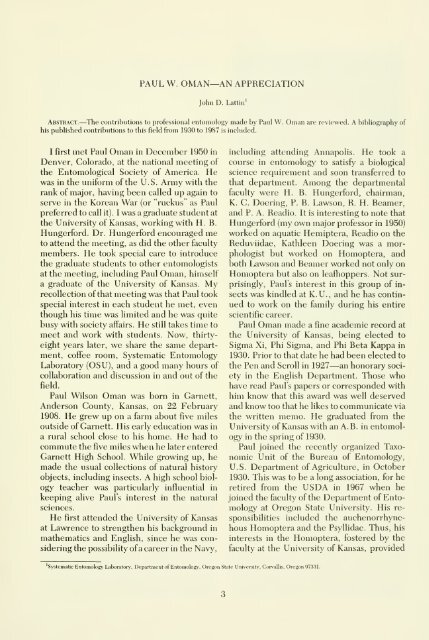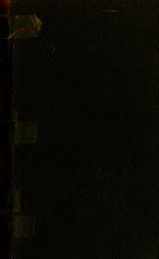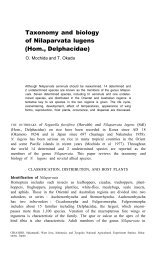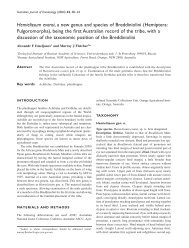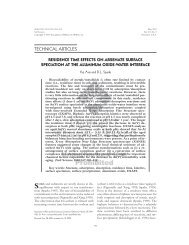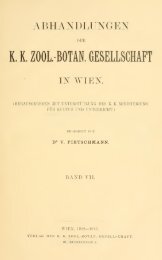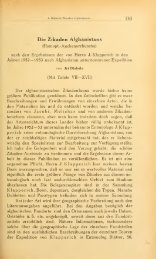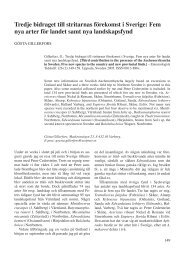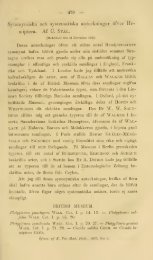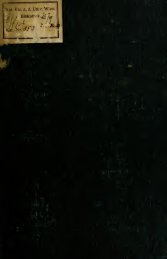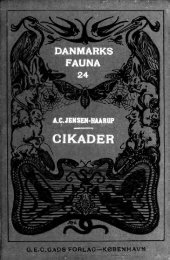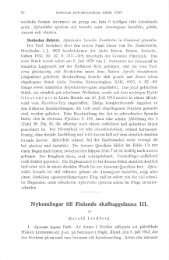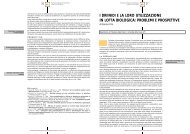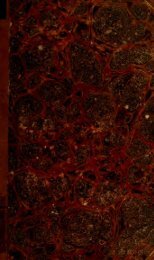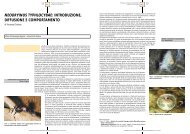Paul W. Oman-an appreciation
Paul W. Oman-an appreciation
Paul W. Oman-an appreciation
You also want an ePaper? Increase the reach of your titles
YUMPU automatically turns print PDFs into web optimized ePapers that Google loves.
PAUL W. OMAN—AN APPRECIATION<br />
John D. Lattin'<br />
Abstract —The contributions to professional entomology made by <strong>Paul</strong> W. <strong>Om<strong>an</strong></strong> are reviewed. A bibliography of<br />
his published contributions to this field from 1930 to 1987 is included.<br />
I first met <strong>Paul</strong> <strong>Om<strong>an</strong></strong> in December 1950 in<br />
Denver, Colorado, at the national meeting of<br />
the Entomological Society of America. He<br />
was in the uniform of the U.S. Army with the<br />
r<strong>an</strong>k of major, having been called up again to<br />
serve in the Kore<strong>an</strong> War (or "ruckus" as <strong>Paul</strong><br />
preferred to call it). I was a graduate student at<br />
the University of K<strong>an</strong>sas, working with H. B.<br />
Hungerford. Dr. Hungerford encouraged me<br />
to attend the meeting, as did the other faculty<br />
members. He took special care to introduce<br />
the graduate students to other entomologists<br />
at the meeting, including <strong>Paul</strong> <strong>Om<strong>an</strong></strong>, himself<br />
a graduate of the University of K<strong>an</strong>sas. My<br />
recollection of that meeting was that <strong>Paul</strong> took<br />
special interest in each student he met, even<br />
though his time was limited <strong>an</strong>d he was quite<br />
busy with society affairs. He still takes time to<br />
meet <strong>an</strong>d work with students. Now, thirty-<br />
eight years later, we share the same department,<br />
coffee room. Systematic Entomology<br />
Laboratory (OSU), <strong>an</strong>d a good m<strong>an</strong>y hours of<br />
collaboration <strong>an</strong>d discussion in <strong>an</strong>d out of the<br />
field.<br />
<strong>Paul</strong> Wilson <strong>Om<strong>an</strong></strong> was born in Garnett,<br />
Anderson County, K<strong>an</strong>sas, on 22 February<br />
1908. He grew up on a farm about five miles<br />
outside of Garnett. His early education was in<br />
a rural school close to his home. He had to<br />
commute the five miles when he later entered<br />
Garnett High School. While growing up, he<br />
made the usual collections of natural history<br />
objects, including insects. A high school biology<br />
teacher was particularly influential in<br />
keeping alive <strong>Paul</strong>'s interest in the natural<br />
sciences.<br />
He first attended the University of K<strong>an</strong>sas<br />
at Lawrence to strengthen his background in<br />
mathematics <strong>an</strong>d English, since he was considering<br />
the possibility of a career in the Navy,<br />
including attending Annapolis. He took a<br />
course in entomology to satisfy a biological<br />
science requirement <strong>an</strong>d soon tr<strong>an</strong>sferred to<br />
that department. Among the departmental<br />
faculty were H. B. Hungerford, chairm<strong>an</strong>,<br />
K. C. Doering, P. B. Lawson, R. H. Beamer,<br />
<strong>an</strong>d P. A. Readio. It is interesting to note that<br />
Hungerford (my own major professor in 1950)<br />
worked on aquatic Hemiptera, Readio on the<br />
Reduviidae, Kathleen Doering was a morphologist<br />
but worked on Homoptera, <strong>an</strong>d<br />
both Lawson <strong>an</strong>d Beamer worked not only on<br />
Homoptera but also on leafhoppers. Not sur-<br />
prisingly, <strong>Paul</strong>'s interest in this group of in-<br />
sects was kindled at K.U., <strong>an</strong>d he has continued<br />
to work on the family during his entire<br />
scientific career.<br />
<strong>Paul</strong> <strong>Om<strong>an</strong></strong> made a fine academic record at<br />
the University of K<strong>an</strong>sas, being elected to<br />
Sigma Xi, Phi Sigma, <strong>an</strong>d Phi Beta Kappa in<br />
1930. Prior to that date he had been elected to<br />
the Pen <strong>an</strong>d Scroll in 1927—<strong>an</strong> honorary society<br />
in the English Department. Those who<br />
have read <strong>Paul</strong>'s papers or corresponded vdth<br />
him know that this award was well deserved<br />
<strong>an</strong>d know too that he likes to communicate via<br />
the written memo. He graduated from the<br />
University of K<strong>an</strong>sas with <strong>an</strong> A.B. in entomology<br />
in the spring of 1930.<br />
<strong>Paul</strong> joined the recently org<strong>an</strong>ized Taxonomic<br />
Unit of the Bureau of Entomology,<br />
U.S. Department of Agriculture, in October<br />
1930. This was to be a long association, for he<br />
retired from the USDA in 1967 when he<br />
joined the faculty of the Department of Entomology<br />
at Oregon State University. His responsibilities<br />
included the auchenorrhynchous<br />
Homoptera <strong>an</strong>d the Psyllidae. Thus, his<br />
interests in the Homoptera, fostered by the<br />
faculty at the University of K<strong>an</strong>sas, provided<br />
Systematic Entomology Laboratory, Department of Entomology, Oregon State University. Corvallis, Oregon 97331.
Fig. 1. <strong>Paul</strong> W. <strong>Om<strong>an</strong></strong>.<br />
his entree into his profession. The need for a<br />
speciahst in the "hard" Homoptera was<br />
prompted by the extensive ecological work<br />
being done on the beet leafliopper <strong>an</strong>d associ-<br />
ated insects, especially in the Twin Falls,<br />
Idaho, region. This fortuitous association with<br />
Circulifer tenellus (Baker), a vector of "curly-<br />
top of beets in the western United States,<br />
also provided a basis of his lifelong interest in<br />
applied systematics—the application of sys-<br />
tematic techniques toward the solution of<br />
problems of concern to society. His ultimate<br />
discovery that this insect was native to the<br />
Middle East (rather th<strong>an</strong> South America as<br />
some thought) (<strong>Om<strong>an</strong></strong> 1936, 1948) lead to explorations<br />
for biological control agents from<br />
the Middle East. Further, this discovery<br />
strengthened his conviction that systematics<br />
should play <strong>an</strong> import<strong>an</strong>t role in biological<br />
control. Some years later, when he assumed<br />
charge of the entomological taxonomic unit of<br />
the US DA, he was instrumental in adding the<br />
biological control unit, resulting in the joint<br />
Great Basin Naturalist Memoirs No. 12<br />
org<strong>an</strong>ization we see today.<br />
During his early years in Washington,<br />
D.C., he attended evening classes at George<br />
Washington University where he majored in<br />
entomology. He had extra courses from the<br />
University of K<strong>an</strong>sas, <strong>an</strong>d these, together<br />
with his course work tr<strong>an</strong>sferred to Lawrence<br />
from George Washington, plus a thesis, resulted<br />
in <strong>an</strong> M.A. degree in entomology from<br />
the University of K<strong>an</strong>sas in 1935. Not surprisingly,<br />
his thesis was on the leafhoppers <strong>an</strong>d<br />
entitled "A Generic Revision of Americ<strong>an</strong><br />
Bythoscopinae <strong>an</strong>d South Americ<strong>an</strong> Jassinae,"<br />
later published in the well-known University<br />
of K<strong>an</strong>sas Science Bulletin (<strong>Om<strong>an</strong></strong> 1938). He<br />
continued his academic work at George<br />
Washington University as time permitted <strong>an</strong>d<br />
received a Ph.D. degree from that institution<br />
in 1941. His thesis, somewhat revised, appeared<br />
under the title, "The Nearctic Leafhoppers<br />
(Homoptera: Cicadellidae), a Gener-<br />
ic Classification <strong>an</strong>d Check List" (<strong>Om<strong>an</strong></strong> 1949).<br />
As Z. P. Metcalf stated (1950, Ann. Entomol.<br />
Soc. Amer. 43: 458), "This is one of the most<br />
outst<strong>an</strong>ding recent contributions to the study<br />
of one of the most difficult families of the<br />
Homoptera, <strong>an</strong>d indeed it was. <strong>Paul</strong> produced<br />
this l<strong>an</strong>dmark publication by working<br />
quietly, steadily, <strong>an</strong>d efficiently, <strong>an</strong>d accom-<br />
plishing a great deal—a <strong>Paul</strong> <strong>Om<strong>an</strong></strong> hallmark.<br />
He was working as a taxonomic specialist at<br />
this time, <strong>an</strong>d so the courses <strong>an</strong>d thesis work<br />
were done largely after hours. He was the<br />
scientist responsible for research on the<br />
Auchenorrhyncha. The hiatus between the<br />
completion of his dissertation <strong>an</strong>d the appear<strong>an</strong>ce<br />
of the published version was caused by<br />
World War II.<br />
<strong>Paul</strong> <strong>Om<strong>an</strong></strong> entered the U.S. Army as a first<br />
lieuten<strong>an</strong>t in the Medical Corps in October<br />
1942 <strong>an</strong>d was assigned to the South Pacific <strong>an</strong>d<br />
the Far East comm<strong>an</strong>ds. He served in that<br />
area, being promoted to captain, until he returned<br />
<strong>an</strong>d left active service in February<br />
1946. While in the South Pacific, he was re-<br />
sponsible for the org<strong>an</strong>ization <strong>an</strong>d direction of<br />
entomological activities on Guadalc<strong>an</strong>al (November<br />
1943-February 1945) <strong>an</strong>d Okinawa<br />
(April-June 1945). Although other medical<br />
entomology problems were involved, the con-<br />
trol of malaria vectors was the chief effort in<br />
both locales. The details of some of these ac-<br />
tivities c<strong>an</strong> be found in <strong>Om<strong>an</strong></strong> <strong>an</strong>d Christenson<br />
(1947) <strong>an</strong>d Harper, Downs, <strong>Om<strong>an</strong></strong>, <strong>an</strong>d
1988 Lattin: <strong>Paul</strong>W. <strong>Om<strong>an</strong></strong><br />
Levine (1963). At the time of his discharge<br />
from the U.S. Army <strong>an</strong>d his return to the<br />
Division of Insect Identification, US DA, he<br />
could hardly <strong>an</strong>ticipate that the experience<br />
gained in medical entomology would be used<br />
again—in 1950, when he was recalled into the<br />
Army to serve three years in the Kore<strong>an</strong> War.<br />
During the four years following his return<br />
from the South Pacific, <strong>Paul</strong> was deeply involved<br />
in the auchenorrhynchous Homoptera.<br />
He became project leader in the Hemiptera<br />
<strong>an</strong>d ultimately assist<strong>an</strong>t division leader<br />
of the Division of Insect Identification. He<br />
published a number of papers, including his<br />
253-page generic classification of the Nearctic<br />
leaflioppers, as well as <strong>an</strong> account of some of<br />
the medical entomology work done in the<br />
South Pacific. His interest in applied system-<br />
atics is reflected in the papers of this period.<br />
In September 1950 he was reactivated to<br />
regular duty in the U.S. Army at the r<strong>an</strong>k of<br />
major <strong>an</strong>d assigned to the Far East during the<br />
Kore<strong>an</strong> War. His first assignment was as entomologist.<br />
Headquarters, 3rd Army. Later he<br />
became chief of the Department of Entomol-<br />
ogy, 406th Medical General Laboratory in<br />
Tokyo, <strong>an</strong>d then comm<strong>an</strong>ding officer. Far<br />
East Medical Research Unit, the position he<br />
held until his discharge in August 1953. He<br />
published several papers dealing with medi-<br />
cal entomology during this time, <strong>an</strong>d, of spe-<br />
cial note to homopterists, a paper describing<br />
three new species of Errhornus with a key to<br />
the species. I doubt that he ever thought he<br />
would devote m<strong>an</strong>y of his later years to <strong>an</strong><br />
intensive study of the genus Errhomus (<strong>Om<strong>an</strong></strong><br />
1987), but we are glad he did.<br />
Once again he was discharged from the<br />
U.S. Army <strong>an</strong>d again returned to the U.S.<br />
Department of Agriculture, this time as the<br />
head of what became the Insect Identification<br />
<strong>an</strong>d Parasite Introduction Research Br<strong>an</strong>ch,<br />
Agricultural Research Service. His systematic<br />
work continued, as did his deep involvement<br />
in all aspects of entomology, entomological<br />
administration, <strong>an</strong>d the Entomological Society<br />
of America. Gradually, his writing beg<strong>an</strong><br />
to reflect his increased responsibilities <strong>an</strong>d his<br />
ever-broadening interests, but always there<br />
was a deep interest in the leaflioppers.<br />
Part of his administrative responsibilities<br />
involved increased international activities.<br />
He was the leader of the United States entomological<br />
delegation to the USSR in 1959 un-<br />
der the U.S. -USSR Scientific <strong>an</strong>d Cultural<br />
Exch<strong>an</strong>ge Program. In October 1960 he<br />
moved to New Delhi, India, to become the<br />
director. Far East Regional Research Office,<br />
Foreign Research <strong>an</strong>d Technical Programs<br />
Division, ARS, USDA. There he was respon-<br />
sible for all technical <strong>an</strong>d administrative as-<br />
pects of agricultural research studies in Asiatic<br />
countries where Public Law 480 funds were<br />
available for research of mutual interest to the<br />
United States <strong>an</strong>d the foreign country.<br />
<strong>Paul</strong> returned home from India in December<br />
1962 to become assist<strong>an</strong>t to the director.<br />
Entomology Research Division, ARS, USDA.<br />
A year later he was appointed assist<strong>an</strong>t direc-<br />
tor of the Entomology Research Division, a<br />
position he retained until he retired from the<br />
U.S. Department of Agriculture in 1967.<br />
<strong>Paul</strong>'s responsibilities included all extramural<br />
research programs, chairm<strong>an</strong> of the Division<br />
Committee for the evaluations of research<br />
personnel, administration of divisional laboratories,<br />
<strong>an</strong>d <strong>an</strong> active role in the pl<strong>an</strong>ning <strong>an</strong>d<br />
development of programs <strong>an</strong>d policies of the<br />
Entomology Research Division. Still he continued<br />
to publish, chiefly on topics related to<br />
his responsibilities with the Division, but he<br />
found time to initiate <strong>an</strong>d participate in the<br />
first conference under the new U.S. -Jap<strong>an</strong><br />
Cooperative Science Program. This confer-<br />
ence, held in Jap<strong>an</strong>, dealt with arthropodborne<br />
pl<strong>an</strong>t viruses (Maramorosch <strong>an</strong>d <strong>Om<strong>an</strong></strong><br />
1966). He was responsible for <strong>an</strong>other U.S.-<br />
Jap<strong>an</strong> Conference held in Washington, D.C.,<br />
in 1967. This time the subject matter was<br />
"Systematics in Relation to the Geographical<br />
Distribution of Insects in the Pacific. " <strong>Paul</strong><br />
<strong>Om<strong>an</strong></strong> <strong>an</strong>d Karl V. Krombein were the org<strong>an</strong>izers<br />
for the United States. It was obvious<br />
that <strong>Paul</strong> was held in high regard by his<br />
Jap<strong>an</strong>ese colleagues. I was pleased to have<br />
been a particip<strong>an</strong>t in that gathering; it was a<br />
special occasion. By this time <strong>Paul</strong> had retired<br />
after 37 years with the U.S. Department of<br />
Agriculture <strong>an</strong>d had joined the faculty of the<br />
Department of Entomology at Oregon State<br />
University, <strong>an</strong>d yet <strong>an</strong>other chapter had begun<br />
in his productive career. He still main-<br />
tains active connections with the USDA, <strong>an</strong>d,<br />
even as this is being written, he is assisting<br />
them to resolve a problem dealing with the<br />
Homoptera.<br />
<strong>Paul</strong> W. <strong>Om<strong>an</strong></strong>, now Professor <strong>Paul</strong> W.<br />
<strong>Om<strong>an</strong></strong>, joined the departmental faculty in the
fall of 1967. He assumed m<strong>an</strong>y ofmy responsi-<br />
bilities in systematic entomology when I<br />
moved into administration. Characteristically,<br />
he launched into his new career with<br />
great energy. He developed his own course in<br />
systematic entomology, developed a course in<br />
adv<strong>an</strong>ces in pest m<strong>an</strong>agement, <strong>an</strong>d beg<strong>an</strong> to<br />
direct graduate student studies. His enormous<br />
experience in all aspects of entomology<br />
made him a highly valued member of the<br />
department, <strong>an</strong>d his advice was sought (<strong>an</strong>d<br />
still is) on m<strong>an</strong>y topics. As program director at<br />
Oregon State University, he participated in<br />
the NSF-funded Inter-University Program in<br />
Pest Population Ecology that r<strong>an</strong> from July<br />
1969 until August 1975, a forerunner of the<br />
IPM programs at OSU we know today. Most<br />
of the leading ecologists of the world were<br />
brought to our campus (<strong>an</strong>d other campuses as<br />
well) under this program. It was obvious that<br />
pest problems were universal problems, <strong>an</strong>d<br />
solid science was required to solve them.<br />
During this time educational turmoil was everywhere,<br />
but these well-org<strong>an</strong>ized programs<br />
provided some academic stability during unstable<br />
times. The Pest Population Ecology<br />
program provided a solid core upon which was<br />
built a revised curriculum.<br />
It took him less th<strong>an</strong> a year to obtain fund-<br />
ing from the National Science Foundation for<br />
his work on the systematics of the lealhop-<br />
pers. This funding extended from 1968 until<br />
he retired in 1975. Again, his publications<br />
reflected his efforts <strong>an</strong>d interests as he pub-<br />
lished a series of leaffiopper papers. At the<br />
same time, he was publishing papers dealing<br />
with other aspects of his activities. He also<br />
renewed his interest in the genus Errhomus<br />
<strong>an</strong>d spent m<strong>an</strong>y seasons in the field carefully<br />
documenting the complex systematic <strong>an</strong>d bio-<br />
geographical problems associated with that<br />
taxon. The result, of course, is the superb<br />
monograph on Errhomus that appeared in<br />
1987. While m<strong>an</strong>y people would be content to<br />
stop there, even before the publication was in<br />
press he took up the world catalog project<br />
with Bill Knight <strong>an</strong>d Merv Nielson. Complacency<br />
is not a characteristic of <strong>Paul</strong> <strong>Om<strong>an</strong></strong>.<br />
<strong>Paul</strong> was curator of the Entomology Museum<br />
from 1967 to 1971. It must have seemed<br />
like child's play after having been responsible<br />
for the entire systematic operation of the<br />
USDA, <strong>an</strong>d yet he took it very seriously <strong>an</strong>d<br />
made major strides in establishing sound pro-<br />
Great Basin Naturalist Memoirs No. 12<br />
tocol for the m<strong>an</strong>agement of the collection.<br />
He added m<strong>an</strong>y needed books <strong>an</strong>d sought out<br />
reprints from major systematists. An active<br />
effort was made to acquire, mount, label, <strong>an</strong>d<br />
accession thous<strong>an</strong>ds of specimens. He made a<br />
special effort to develop the Homoptera col-<br />
lection that had l<strong>an</strong>guished. During the years<br />
since his release as official curator, he has<br />
added literally tens of thous<strong>an</strong>ds of specimens<br />
to the collection, <strong>an</strong>d still continues to add<br />
more. These specimens are all mounted, la-<br />
beled, <strong>an</strong>d, if leaflioppers, identified, <strong>an</strong>d cu-<br />
rated. Talk about a curator's dream! We all<br />
know that collections become major scientific<br />
resources because of the work of m<strong>an</strong>y people<br />
with a common goal. <strong>Paul</strong> is the epitome of<br />
such a person.<br />
During the ensuing years he served entomology<br />
in m<strong>an</strong>y ways. He was on the editorial<br />
board of the Annual Review of Entomology<br />
from 1972 to 1976. He was chairm<strong>an</strong> of the ad<br />
hoc Committee on Entomological Collections<br />
in the United States. He was a member of the<br />
Entomological Society of America Advisory<br />
Committee on Systematic Resources in Entomology<br />
from 1973 to 1975. He was a member<br />
of the National Policy Advisory Committee<br />
(NSF) for the National Drosophila Species Resource<br />
Center in 1975. He was secretary of a<br />
study team that prepared a 138-page report in<br />
1978 entitled "Biological Agents for Pest Con-<br />
trol: Status <strong>an</strong>d Prospects ' for the USDA in<br />
cooperation with l<strong>an</strong>d-gr<strong>an</strong>t universities, the<br />
State Department of Agriculture, <strong>an</strong>d the<br />
Agricultural Research Institute.<br />
When his long-time friend <strong>an</strong>d colleague,<br />
Knud Swenson, then chairm<strong>an</strong> of our department,<br />
was forced to step down because of a<br />
tragic illness, <strong>Paul</strong> took over as acting chairm<strong>an</strong>.<br />
He served in that capacity from 1973 to<br />
1974 while the department sought a new department<br />
chair. His long experience in science<br />
administration was most evident during<br />
that time, <strong>an</strong>d we were able to experience yet<br />
<strong>an</strong>other facet of his skills. He was a low-key,<br />
but a most efficient <strong>an</strong>d effective, administrator.<br />
He paid attention to detail <strong>an</strong>d provided<br />
leadership <strong>an</strong>d stability that created <strong>an</strong> atmosphere<br />
of professionalism. He rarely com-<br />
plained <strong>an</strong>d favored working out a solution to a<br />
problem. Because his dedication to the job at<br />
h<strong>an</strong>d was always evident, people responded<br />
in a similar fashion. He was especially effec-<br />
tive in getting the most out of the resources<br />
available to him.
1988 Lattin: <strong>Paul</strong> W. <strong>Om<strong>an</strong></strong><br />
<strong>Paul</strong> <strong>Om<strong>an</strong></strong> retired in 1975—again. There<br />
was only <strong>an</strong> imperceptible ch<strong>an</strong>ge before <strong>an</strong>d<br />
after this date—occasionally he would head<br />
for the golf course if the afternoon was espe-<br />
cially nice. Although I have never played golf<br />
with <strong>Paul</strong>, I know some who have—be prepared<br />
for a fierce competitor <strong>an</strong>d don t wager<br />
very much on each hole. During the past 13<br />
years of his "retirement" he has averaged six to<br />
eight hours a day in his office, has spent hun-<br />
dreds of hours in the field throughout the<br />
West, has given m<strong>an</strong>y reading <strong>an</strong>d conference<br />
courses to m<strong>an</strong>y students, has served on numerous<br />
graduate student committees, has<br />
hosted foreign scientists <strong>an</strong>d freely shared<br />
with them his vast experience with the Ci-<br />
cadellidae, <strong>an</strong>d has identified thous<strong>an</strong>ds of<br />
leafhoppers for m<strong>an</strong>y individuals <strong>an</strong>d institu-<br />
tions.<br />
One of my most recent interactions with<br />
<strong>Paul</strong> occurred on 16 March 1988, when he<br />
participated in the program pl<strong>an</strong>ning session<br />
for Adam Asquith, one of my new doctoral<br />
students. <strong>Paul</strong> had given Adam a reading <strong>an</strong>d<br />
conference course in zoological nomenclature<br />
during the preceding three months. In fact,<br />
one of the other graduate committee members<br />
brought a particularly knotty problem on<br />
nomenclature to the meeting. Ultimately, the<br />
problem was resolved by <strong>Paul</strong> <strong>an</strong>d Adam. <strong>Paul</strong><br />
brought several current articles from science<br />
that were appropriate to the graduate program<br />
<strong>an</strong>d the proposed thesis topic. He has<br />
always given help freely to the students <strong>an</strong>d<br />
faculty, <strong>an</strong>d he did so again on 16 March 1988.<br />
His eightieth birthday had been celebrated<br />
three weeks earlier, <strong>an</strong>d he had supposedly<br />
retired in 1975, but for <strong>Paul</strong> <strong>Om<strong>an</strong></strong> it was just a<br />
regular day.<br />
As one who has known him since 1950, 1 c<strong>an</strong><br />
attest to his m<strong>an</strong>y contributions <strong>an</strong>d deep<br />
devotion to entomology. He joined the ESA<br />
in 1929, served as president in 1959, was<br />
elected <strong>an</strong> honorary member in 1975, <strong>an</strong>d<br />
received the Woodworth Award from the<br />
Pacific Br<strong>an</strong>ch in 1982. He joined our faculty<br />
in 1967, <strong>an</strong>d while he holds the title Emeritus<br />
Professor of Entomology, his efforts are indis-<br />
tinguishable from those of regular faculty<br />
members. He is one of those rare scientists<br />
whose influence has extended far beyond his<br />
office <strong>an</strong>d laboratory. I cherish our friendship.<br />
<strong>Paul</strong> Wilson <strong>Om<strong>an</strong></strong> Bibliography<br />
L <strong>Om<strong>an</strong></strong>, P. W. 1930. A new Paracoelidia (Homoptera:<br />
Cicadellidae). J. K<strong>an</strong>sas Entoniol. Soc. 3; 78-79.<br />
2. <strong>Om<strong>an</strong></strong>, P. W. 193L Some new Neocoelidia with notes<br />
on other species (Homoptera: CicadelHdae). J.<br />
K<strong>an</strong>sas Entomol. Soc. 4: 62-68.<br />
3. <strong>Om<strong>an</strong></strong>, P. W. 1931. Newjassinae, with notes on other<br />
species. J. Washington Acad. Sci. 21: 430-436.<br />
4. <strong>Om<strong>an</strong></strong>, P. W. 19.32. Two new Laevicephalus from<br />
CaUfornia. Proc. Entomol. Soc. Washington 34:<br />
90-92.<br />
5. <strong>Om<strong>an</strong></strong>, P. W. 19.33. A classification of North Americ<strong>an</strong><br />
agalli<strong>an</strong> leaflioppers. U.S. Dept. Agric. Tech.<br />
Bull. 372. 93 pp.<br />
6. <strong>Om<strong>an</strong></strong>, P. W. 1933. Phlepsius ishidae Matsumura in<br />
North America. Proc. Entomol. Soc. Washington<br />
35: 205-206.<br />
7. <strong>Om<strong>an</strong></strong>, P. W. 19.34. New species <strong>an</strong>d a new genus of<br />
deltocephaline leaflioppers (Hemiptera: Ho-<br />
moptera). Proc. Entomol. Soc. Washington 36:<br />
75-81.<br />
8. <strong>Om<strong>an</strong></strong>, P. W. 1934. South Americ<strong>an</strong> leafhoppers of<br />
the genus Agalli<strong>an</strong>a. Rev. de Entomol. 4:<br />
333-340.<br />
9. <strong>Om<strong>an</strong></strong>, P. W. 1934. The agalli<strong>an</strong> leafhoppers of the<br />
Biologia material. Ann. Entomol. Soc. Amer. 27:<br />
445-461.<br />
10. <strong>Om<strong>an</strong></strong>, P. W. 1935. New North Americ<strong>an</strong> agalli<strong>an</strong><br />
leafhoppers with notes on other species. J. K<strong>an</strong>sas<br />
Entomol. Soc. 8: 9-16.<br />
11. <strong>Om<strong>an</strong></strong>, P. W. 1936. New Neotropical empoasc<strong>an</strong><br />
leaflioppers. J. Washington Acad. Sci. 26: 34-40.<br />
12. <strong>Om<strong>an</strong></strong>, P. W. 1936. A new Poblicia from Texas (Ho-<br />
moptera: Fulgoridae). J. K<strong>an</strong>sas Entomol. Soc. 9:<br />
105-107.<br />
13. <strong>Om<strong>an</strong></strong>, P. W. 1936. Two new leaflioppers from tropical<br />
America. P<strong>an</strong>-Pac. Entomol. 12: 116-119.<br />
14. <strong>Om<strong>an</strong></strong>, P. W. 1936. Distributional <strong>an</strong>d synonymical<br />
notes on the beet leafhopper, Eutettix tenellus<br />
(Baker). Proc. Entomol. Soc. Washington 38:<br />
164-165.<br />
15. <strong>Om<strong>an</strong></strong>, P. W. 1936. South Americ<strong>an</strong> leafhoppers of<br />
the genus Xerophloea Gerniar (Homoptera). Rev.<br />
de Entomol. 6: 394-401.<br />
16. <strong>Om<strong>an</strong></strong>, P. W. 1937. Fossil Hemiptera from the Fox<br />
Hills S<strong>an</strong>dstone (Cretaceous) of Colorado. J. Pale-<br />
ontol. 11:38.<br />
17. <strong>Om<strong>an</strong></strong>, P. W. 1937. The leaflioppers of the genus<br />
Scaphoidula (Homoptera: Cicadellidae). Rev. de<br />
Entomol. 7: 92-96.<br />
18. <strong>Om<strong>an</strong></strong>, P. W. 1937. The cinerosus group of the genus<br />
Laevicephalus (Homoptera: Cicadellidae). J.<br />
Washington Acad. Sci. 27: 474-479.<br />
19. <strong>Om<strong>an</strong></strong>, P. W. 1937. New eupterygine leafhoppers<br />
from Puerto Rico (Homoptera: Cicadellidae).<br />
Univ. Puerto Rico J. Agric. 21: 567-.572.<br />
20. <strong>Om<strong>an</strong></strong>, P. W. 1938. A generic revision of the Ameri-<br />
c<strong>an</strong> Bythoscopinae <strong>an</strong>d South Americ<strong>an</strong> Jassinae.<br />
Univ. K<strong>an</strong>sas Sci. Bufl. 24: 343-420.<br />
21. <strong>Om<strong>an</strong></strong>, P. W. 1938. A contribution to the classification<br />
of South Americ<strong>an</strong> agalli<strong>an</strong> leafhoppers. Ann.<br />
Carnegie Museum 25: 351-460.<br />
22. <strong>Om<strong>an</strong></strong>, P. W. 1938. Revision of the Nearctic leaflioppers<br />
of the tribe Errhomenellini (Homoptera:
Cicadellidae). Proc. U.S. National Museum 85:<br />
16.3-180.<br />
23. <strong>Om<strong>an</strong></strong>, P. W., <strong>an</strong>d N<strong>an</strong>cy H. Wheeler. 19.38. The<br />
North Americ<strong>an</strong> empoasc<strong>an</strong> leafhoppers of the aspersa<br />
group (Homoptera; Cicadellidae). Proc. En-<br />
tomol. Soc. Washington 40: 1,33-147.<br />
24. <strong>Om<strong>an</strong></strong>, P. W. 1939. Revision of the genus Cpra
1988 Lattin: <strong>Paul</strong> W. <strong>Om<strong>an</strong></strong><br />
Washington 72; 30-32.<br />
62. <strong>Om<strong>an</strong></strong>, P. 1970. The Oregon State University insect<br />
collection. Bull. Entomol. Soc. of Amer. 16: 165.<br />
63. <strong>Om<strong>an</strong></strong>, P. 1971. A new Agallia from the western<br />
United States. J. K<strong>an</strong>sas Entomol. Soc. 44: 325-<br />
372.<br />
64. <strong>Om<strong>an</strong></strong>, P. 1971. The iema\e oiThatuna gilletti <strong>Om<strong>an</strong></strong>,<br />
with biological notes. Proc. Entomol. Soc.<br />
Washington 73: 368-372.<br />
65. <strong>Om<strong>an</strong></strong>, P. 1972. Documentation of biological control<br />
operations. International Org<strong>an</strong>ization for Biologi-<br />
cal Control, Western Hemisphere Region Sec.<br />
Newsletters: 1-2.<br />
66. <strong>Om<strong>an</strong></strong>, P. 1972. A new megophthalmine leafhopper<br />
from Oregon, with notes on its biology <strong>an</strong>d behavior<br />
(Homoptera: Cicadellidae). Royal Entomol.<br />
Soc. London, J. Entomol. (B)41: 69-76.<br />
67. <strong>Om<strong>an</strong></strong>, P. 1972. The lealliopper subfamily Koebeli-<br />
inae (Homoptera: Cicadellidae). Published as part<br />
of a Festschrift honoring Professor K. Yasumatsu<br />
of Jap<strong>an</strong>, pp. 129-139 (dated 1971, issued 1972).<br />
68. <strong>Om<strong>an</strong></strong>, P. 1974. Curtis P. Clausen ('32). (A vignette.)<br />
Cosmos Club Bull. 27: 3-5.<br />
69. <strong>Om<strong>an</strong></strong>, P. 1974. Identification <strong>an</strong>d classification in<br />
pest m<strong>an</strong>agement <strong>an</strong>d control. Pages 77-86 in F.<br />
G. Maxwell <strong>an</strong>d F. A. Harris, eds., Proc. Summer<br />
Institute on Biological Control of Pl<strong>an</strong>t Insects <strong>an</strong>d<br />
Diseases. University of Mississippi Press, Jack-<br />
son. 647 pp.<br />
70. <strong>Om<strong>an</strong></strong>, P., <strong>an</strong>d C. A. Musgrave. 1975. The Nearctic<br />
genera of Errhomenini (Homoptera: Cicadellidae).<br />
Mel<strong>an</strong>deria21: 1-14.<br />
71. <strong>Om<strong>an</strong></strong>, P. 1976. Review of World catalogues of the<br />
Homoptera: Auchenorrhyncha. Bull. Entomol.<br />
Soc. Amer. 22: 161-164.<br />
72. Gill, R. J., <strong>an</strong>d <strong>Paul</strong> <strong>Om<strong>an</strong></strong>. 1982. A new species <strong>an</strong>d<br />
new distributional records for megophthalmine<br />
leafhoppers, genus Tiaja (Homoptera: Cicadellidae).<br />
Entomography 1; 281-288.<br />
73. Klein, M., B. Raccah, <strong>an</strong>d P. W. <strong>Om<strong>an</strong></strong>. 1982. The<br />
occurrence of a member of the Circulifer tenellus<br />
species complex (Homoptera: Cicadellidae: Euscelini)<br />
in Israel. Phytoparasitica 10(4): 237-240.<br />
74. Converse, R. H., R. G. Clarke, P. W. <strong>Om<strong>an</strong></strong>, Sr., <strong>an</strong>d<br />
G. M. Milbrath. 1982. Witches' broom disease of<br />
black raspberrv in Oregon. Pl<strong>an</strong>t Disease 66(10):<br />
949-951.<br />
75. Lattin, J. D., <strong>an</strong>d P. <strong>Om<strong>an</strong></strong>. 1983. Where are the<br />
exotic insect threats? Pages 93-137 in Charles<br />
L. Wilson <strong>an</strong>d Charles L. Graham, eds.. Exotic<br />
pl<strong>an</strong>t pests <strong>an</strong>d North Americ<strong>an</strong> agriculture. Academic<br />
Press. 498 pp.<br />
76. <strong>Om<strong>an</strong></strong>, P. 1985. A synopsis of the Nearctic<br />
Dorycephalinae (Homoptera: Cicadellidae). J.<br />
K<strong>an</strong>sas Entomol. Soc. 58: 314-336.<br />
77. <strong>Om<strong>an</strong></strong>, P., <strong>an</strong>d R. 1. Sailer. 1986. The role of catalog-<br />
ing in the adv<strong>an</strong>cement of systematics <strong>an</strong>d biogeography.<br />
Tymbal (Auchenorrhyncha Newsletter)<br />
7: 16-21.<br />
78. <strong>Om<strong>an</strong></strong>, P. 1987. Alary polymorphism in the Cicadelli-<br />
dae <strong>an</strong>d its ecological implications. Pages 55-63 in<br />
M. R. Wilson <strong>an</strong>d L. R. Nault, eds.. Proceedings<br />
of the 2nd International Workshop on Leafhop-<br />
pers <strong>an</strong>d Pl<strong>an</strong>thoppers of Economic Import<strong>an</strong>ce.<br />
C.A.B. International Institute of Entomology. 368<br />
pp.<br />
79. <strong>Om<strong>an</strong></strong>, P. 1987. The leafhopper genus Errhomus<br />
(Homoptera: Cicadellidae: Cicadellinae): system-<br />
atics <strong>an</strong>d biogeography. Oregon State University,<br />
Department of Entomology, Systematic Entomology<br />
Laboratory Misc. Pub. No. 1: 1-72.


